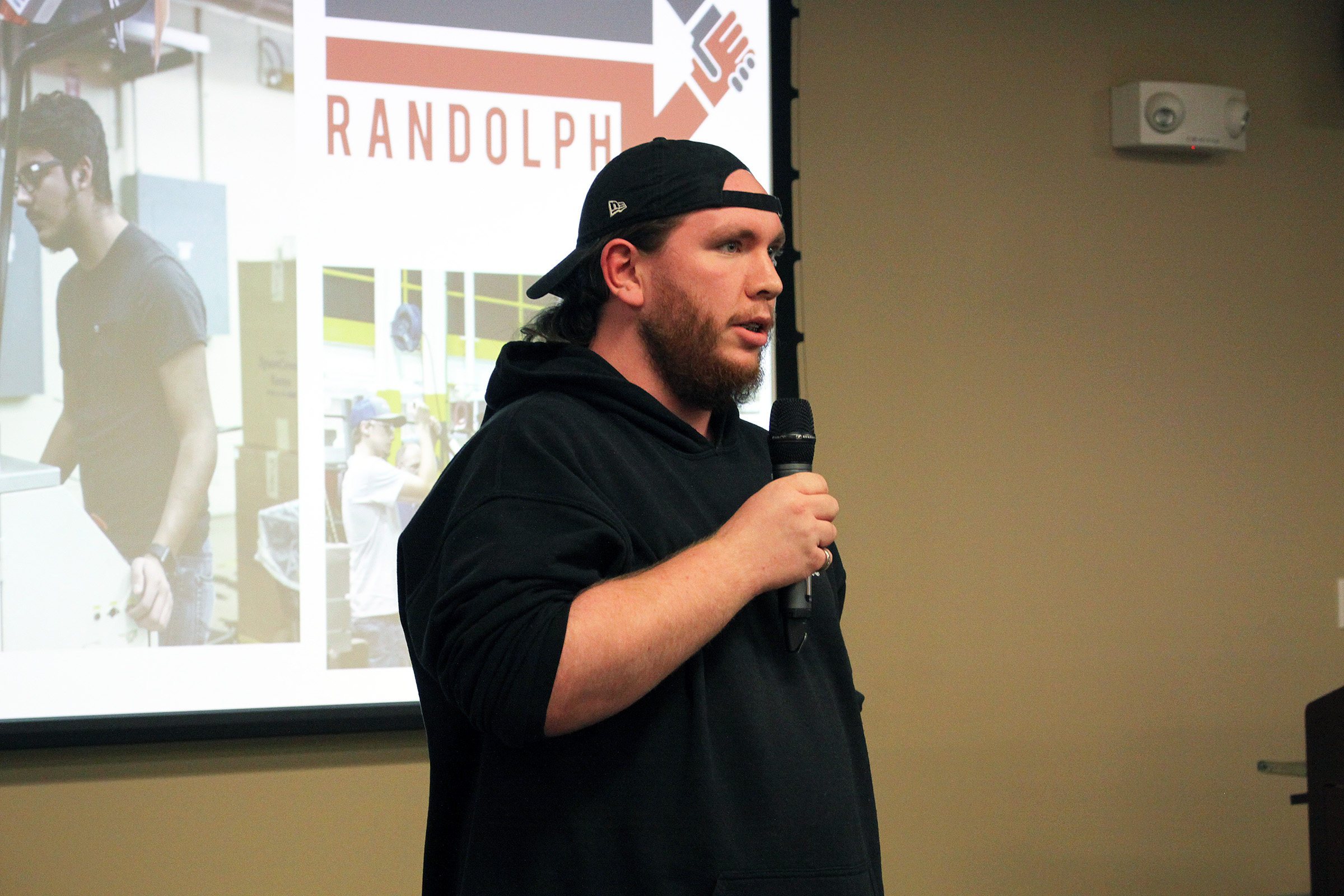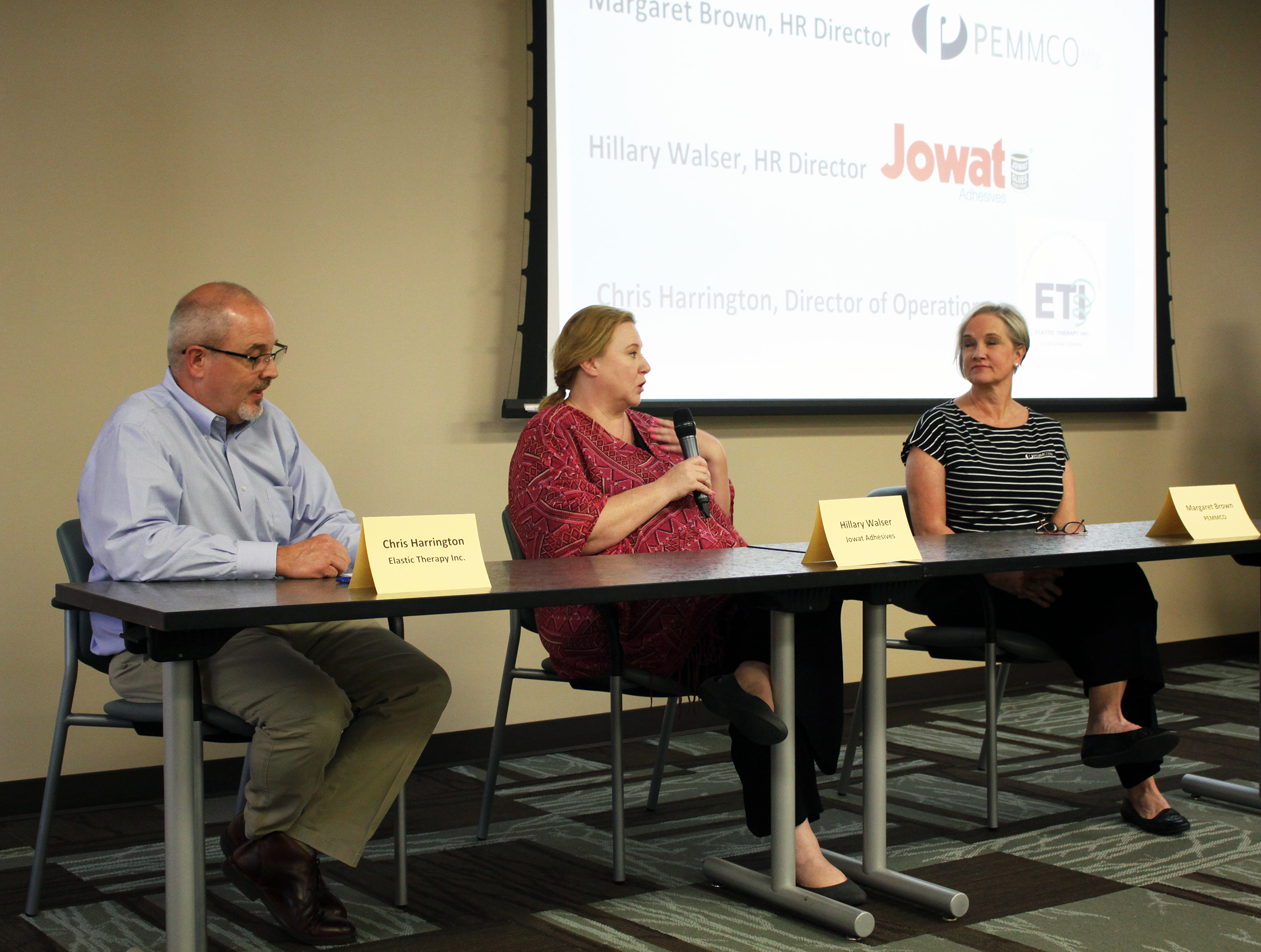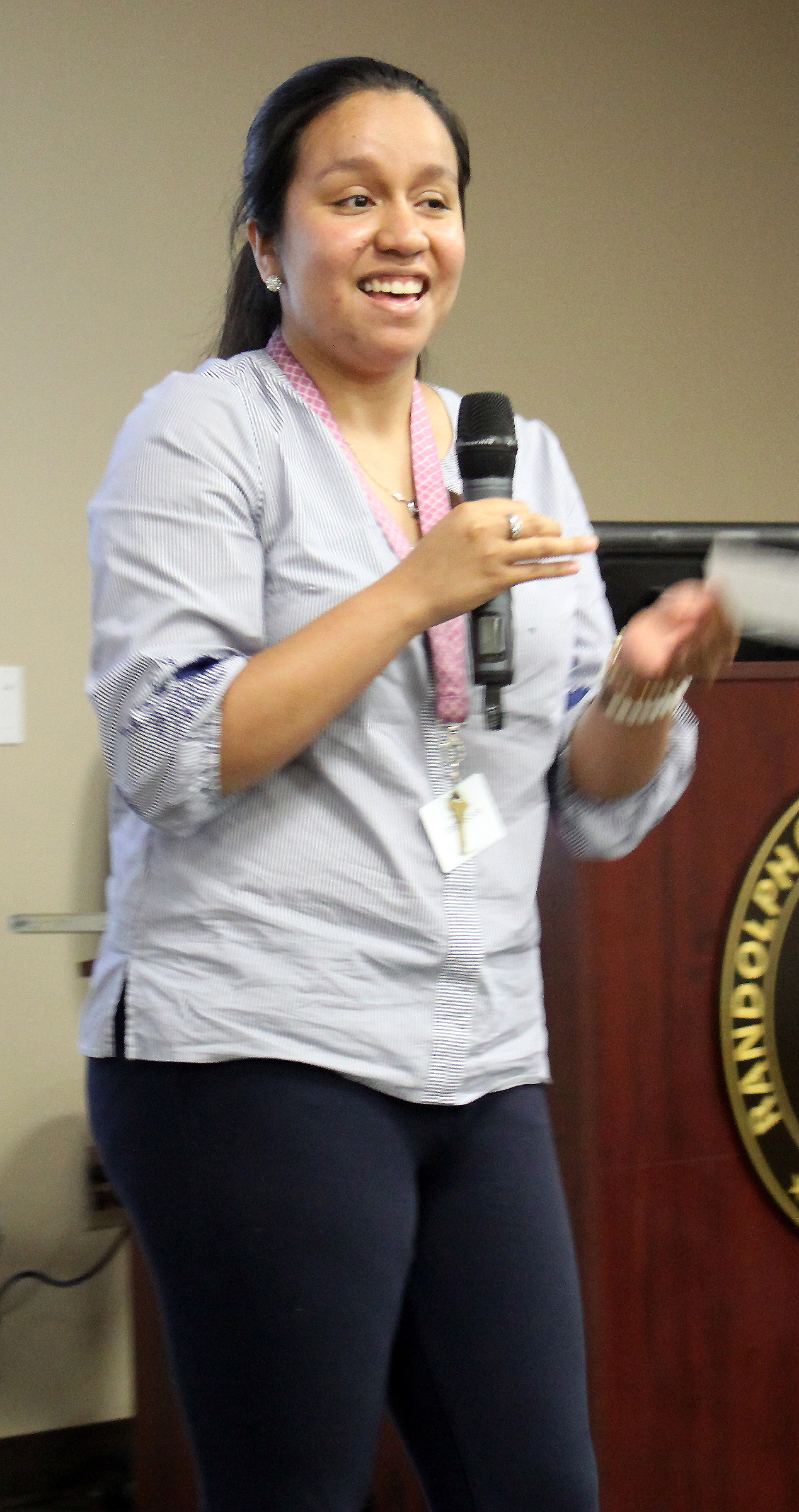AMP Summit shines light on Manufacturing Pathway progress

ASHEBORO — Members of Randolph Community College (RCC), the Randolph County School System (RCSS), Asheboro City Schools (ACS); local industry representatives, and community partners gathered Tuesday, May 21, in RCC’s JB & Claire Davis Corporate Training Center for an AMP (Advanced Manufacturing Pathway) Summit to share what has developed out of the Pathways to Prosperity Advanced Manufacturing Pathway that was released in April 2015.

Chris Harrington of Elastic Therapy Inc., Hillary Walser of Jowat Adhesives, and Margaret Brown of PEMMCO Manufacturing discuss the current state of manufacturing in Randolph County.
After RCC President Dr. Robert Shackleford Jr. welcomed the summit attendees, RCC Pathways Activities Coordinator Stacey Miller gave an update on Pathways to Prosperity.
“The manufacturing technology pathway came about when ... the schools, the industries, and the community partners met to discuss the workforce needs and lay out a course of action,” Miller said. “The Pathways to Prosperity project essentially allows us to focus on making students not only college ready, but career ready.”
Miller then presented three industry members for a State of Manufacturing Panel discussion — PEMMCO Manufacturing Human Resources Director Margaret Brown, Jowat Adhesives Human Resources Director Hillary Walser, and Elastic Therapy Inc. Director of Operations and Co-Chairman of Apprenticeship Randolph Chris Harrington. All three said their respective industries are constantly growing and in need of employees.
“I grew up in manufacturing; manufacturing in 2019 is not manufacturing in 1975,” Brown said. “One of the struggles we’ve had has been longevity. Instilling in [our employees] that this is a career, it’s not just a job. It’s computer skills. It’s math skills. It’s not the old assembly-line mentality. It can be exciting. It’s very creative now.”
Walser stressed the need for critical-thinking skills.
“We cannot teach them teamwork — those soft skills that aren’t being taught currently outside the advanced manufacturing program,” she said. “The biggest thing we’re facing now is we have an aging population. If you look at my company, the average age right now is 41-years-old. We are finding that some of our older employees are struggling with that transition to the newer technologies.”
Harrington said his industry has had to try and shed the stigma in textiles.
“We’ve really had to help people understand that textiles really is advanced manufacturing,” he said. “We have a gray tsunami facing us — about a third of our workforce is within five years or less of age 65. At the same time, we’re facing Industry 4.0, so 10 to 50 percent of the workforce is going to have to change skills.
“It really comes down to changing the narrative. For decades, it was college for all. The reality is — college is a great pathway, but only a third of the jobs in American require a four-year college degree. We need to say, ‘What’s the job and what are the credentials needed for the job?’ ”
All three made suggestions for future pathways, including logistics, quality technicians, sales, IT, and leadership.

Brown lauded the Apprenticeship Randolph program for high school juniors and seniors, which begins with a six-week, pre-apprenticeship summer program that consists of two RCC classes and 40 hours per week of on-the-job training. Once a business selects its apprentice after this trial period, the program is spread over four years with students receiving paid, on-the-job training. The program, in its third year, boasts 20 participating companies and 34 pre-apprentices.
“The apprenticeship program has been one of the greatest programs Randolph County and Asheboro have ever had,” Brown said. “You bring these eighth-grade kids into your plant and you take them to your apprentice, who is not that far from their age. They can help them understand — ‘I’m going to school for free, I’m getting a paycheck, I’m going to have benefits once I come on full-time.’ ”
Rocky Lewis, an apprentice with Elastic Therapy Inc., credited the program with changing his life.
“When I left high school, I didn’t have a plan to go to college,” he said. “I didn’t have the money. My mom was living paycheck to paycheck, if not less. I realized I needed a job. One of my teachers mentioned this program to me. This opened up a whole new door for me — things I’d never thought I’d be able to, get a new car by myself or get loans.”
Several presenters followed who discussed joint initiatives, starting with RCC Vice President for Instructional Services Suzanne Rohrbaugh, who discussed the Golden LEAF Foundation grant that helped RCC to update equipment, ACS begin a manufacturing program on-site, and Eastern Randolph High School (RCSS) build a metals manufacturing lab for its new program.
Miller presented Manufacturing Day, which introduces 450 eighth- and 10th-grade students to manufacturing with tours of local industries and RCC’s Gene Haas Computer-Integrated Machining Institute and welding labs, and hands-on activities.
Randleman High School Assistant Principal Emily Stevenson discussed her participation in Career Focus Fridays and Insider Tour Tuesdays, which allows local school staff and faculty to tour five local industries.
“This was an eye-opening experience,” she said. “It has made a critical impact in what our students are choosing to do. We have an increase in the number of apprentices we had apply to Apprenticeship Randolph, but also get accepted because they were aware of the opportunities in Randleman’s backyard.”
RCSS Career Technical Education (CTE) Director Nancy Cross talked about Job Shadow Day, which brought 40 juniors from area high schools spent three hours in the morning or afternoon job-shadowing Feb. 1 (Groundhog Day). She noted that one of the highlights was students not only learning what they wanted to do for a career, but also what they did not want to do.
Asheboro High School math teacher Mireida Perez-Cortez participated in Summer Teacher Camp — a weeklong internship that puts teachers in today’s workplace.
“Before I went to Timken, I had no clue what a bearing was,” she said. “I learned they use graphs, which was great because when I went back to the classroom, my students said, ‘Why are we using this?’ I said, ‘Well, you need to learn how to use a graph and read it.’ I told them how you have to have good communication skills and teamwork and be punctual.”
Student Alonzo Castro Perez, AHS business teacher Wes Berrier, and Uwharrie Ridge science teacher Sarah Fuller all participated in AMP Camp — a weeklong camp for 20 seventh- and eighth-graders and 20 teachers. All three said it was enlightening.
“College is not for all the students,” Fuller said, “so they wonder, ‘What do I do?’ I can tell them what kind of jobs are here close to home. I learned what kinds of things I can pull into my classroom to better prepare them for those jobs.”
ACS CTE Coordinator Sarah Beth Robbins and Cross both presented their respective school systems’ Pathways initiatives, including Comets to Careers (ACS) and Systematic Career Development (RCSS). The initiatives are for students from fifth to 12th grade.
“By starting that conversation at a younger age fewer students will be in Rocky’s situation senior year, saying, ‘What do I do now?’ ” Cross said. “We have three major initiatives for our students: One, they should graduate from high school with some sort of industry-recognized credential. Last year the [RCSS] ranked fourth in number of credentials earned — we are the 22nd largest school system and we had over 8,000 credentials through CTE classes. Two, every student should have the opportunity to take community college classes before they graduate high school. We more than quadrupled the number of students accessing courses through RCC over last four years. Lastly, our students should all have work-based learning experience.”
The Pathways to Prosperity project is based on a report, “Pathways to Prosperity: Meeting the Challenge of Preparing Young Americans for the 21st Century,” released in 2011 by the Harvard Graduate School of Education, in which school systems are “called to align Career & Technical Education (CTE) courses with area and state labor market demands and create a system of career-focused pathways that span the last years of high school and at least one year of postsecondary education or training that leads to an industry-recognized certification or credential.”
The second Pathways initiative in 2016 focused on creating health care pathways, while the third partnership project, which debuted in April 2018, focuses on agriculture and includes the development of a new associate degree in Agribusiness Technology at RCC.
